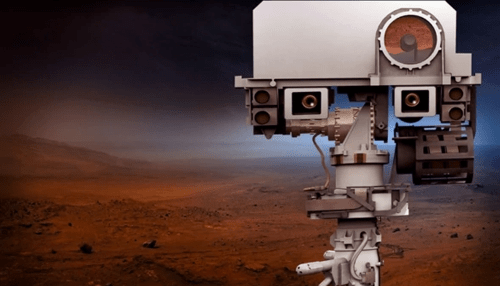This artist’s rendition shows the topmast of NASA’s Mars 2020 rover as it might appear as the trundles across the Martian surface. Before the mission reaches Mars, however, it must first overcome several difficult developmental obstacles.
An independent review has identified several areas of concern in the development of NASA’s next Mars rover, which the space agency aims to launch in July 2020.
The technologies required for the 2020 Mars rover mission’s sample-collecting system appear to be relatively immature, for example, and five of the robot’s seven science instruments feature a “condensed development schedule,” said a new report by NASA’s Office of Inspector General (OIG).
ALSO READ: NASA GROWING LETTUCE IN SPACE
These and several other issues may affect Mars 2020 project managers’ ability to achieve the mission’s technical objectives, meet project milestones (such as the intended launch date) and control costs, said the OIG report, which was published Monday (Jan. 30). [NASA’s Mars Rover 2020 Mission in Pictures (Gallery)]
The OIG conducts objective oversight of NASA programs and operations and independently reports its findings to the space agency’s administrator, Congress, and the public.
“OVERLY OPTIMISTIC” PROJECT?
As noted in the OIG document, since 1964, NASA has spent more than $21 billion on missions exploring Mars, including four robotic rovers on the Martian surface, five static landers, and numerous orbiters.
Mars 2020 is NASA’s next big Red Planet surface mission. The $2.4 billion robot’s body is heavily based on the Curiosity rover, which has been exploring Mars since August 2012. The new mission aims to hunt for signs of past Red Planet life and collect and store samples that will be retrieved by a future mission, among other goals.
Mars 2020 has several schedule-related issues that could indicate the project is “overly optimistic,” the new report said. The largest risk is the rover’s sample and caching subsystem, according to the document.
ALSO READ: HOW TO WIN NASA’S $30,000 ‘SPACE POOP’ CHALLENGE
Three of the sampling system’s critical technologies were below technology-readiness level (TRL) 6 at the mission’s preliminary design review (PDR) in February 2016—meaning their prototypes “had not yet demonstrated the capability to perform all the functions required,”
“The immaturity of the critical technologies related to the sampling system is concerning, because, according to Mars 2020 project managers, the sampling system is the rover’s most complex new development component, with delays likely to eat into the project’s schedule reserve, and in the worst-case scenario, [they] could delay the launch,” the report added. “As of December 2016, the project was tracking the risk that the sampling system may not be ready for integration and testing—the period when a spacecraft is built undergoes final testing and is prepared for launch—in May 2019, as planned.”
Several other challenges confront Mars 2020 project managers, the OIG document reported.
Among these are “late delivery of actuators (the components responsible for moving and controlling parts and instruments on the rover); foregoing an engineering model of the Mars Oxygen In-Situ Resource Utilization Experiment (MOXIE) designed to assess the feasibility of producing oxygen on Mars as a cost-savings measure; ensuring the rover does not exceed its designed mass limit of 1,050 kilograms [2,315 lbs.]; and addressing foreign-partner funding issues that may affect their ability to timely deliver components to the project.”
Overall, five of the 2020 rover mission’s seven identified “critical technologies” were not at the recommended TRL 6 by the time of PDR in February 2016, according to the OIG report. But the document notes that, by December 2016, Mars 2020 project personnel were showing all seven technologies as having reached TRL 6.
ALSO READ: US MUST COLLABORATE MORE ON SPACE RESEARCH : NASA
MASS MONITORING
The OIG also noted that the Mars 2020 team is redesigning the new rover’s wheels in an attempt to protect against the wear and tear that Curiosity has experienced during its 4.5 years on the Red Planet.
Mars 2020’s wheels will be twice as thick as Curiosity’s and add 22 lbs. (10 kg) of mass to the new rover. Mars 2020 engineers are also considering making software changes to improve the rover’s ability to match wheel drive with the terrain of the terrain of Red Planet terrain, the new report said.
Although project managers do not foresee further mass growth of the Mars 2020 rover, they are monitoring the mass and volume of the turret at the end of the six-wheeled robot’s arm, the OIG report stated. If necessary, additional steps can be taken to keep the rover’s mass below 2,315 lbs. (1,050 kg). These steps could include removing a proposed helicopter technology demonstration from the mission. (This mini copter would fly ahead of the rover, helping to scout out optimal driving routes and spots of scientific interest on the Martian surface, according to the OIG report.)
ALSO READ: WORLD’S BIGGEST SPACE TELESCOPE BUILDS: WILL LAUNCH IN 2018
PLANNED ACTIONS
NASA is taking measures to address the issues raised by the report, OIG officials said.
“We provided a draft of this report to NASA management, who concurred with our recommendations and described planned actions to address them,” the OIG report stated.
You can read the full OIG report here: https://oig.nasa.gov/audits/reports/FY17/IG-17-009.pdf
- Destination Mars: NASA’s 2020 Mars Rover Science Plan | Video
- Mars Myths & Misconceptions: Quiz
- Mars Explored: Landers and Rovers Since 1971 (Infographic)
- Curiosity’s Sister to Launch to Mars in 2020 | Video
Article Originally Published by Leonard David | SPACE.COM


